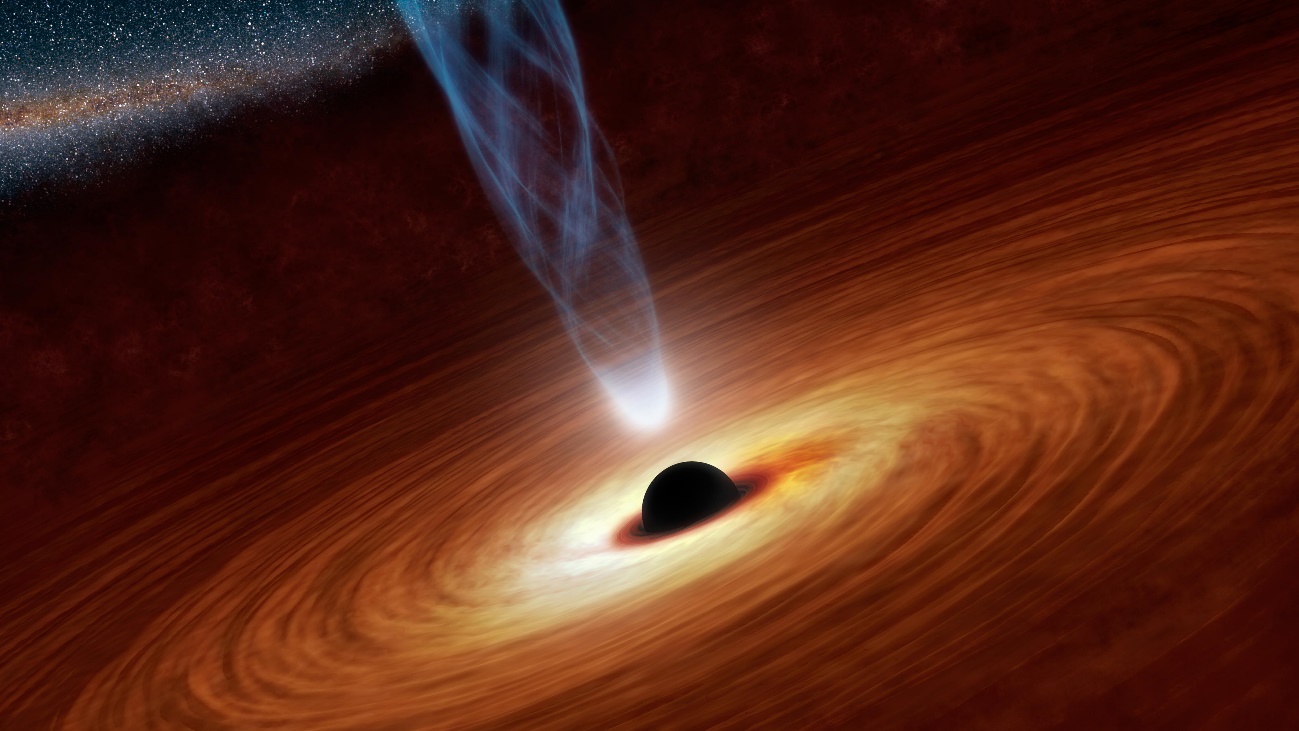Supermassive black holes found in distant dwarf galaxies

The study presents a sample of seven dwarf galaxies, between 10 and 6 billion years after the Big Bang, that host supermassive black holes
Scientists had only found similar cases in the current Universe, 13.6 billion years after the Big Bang
This discovery raises new questions in the study of the evolution of black holes
An international team with the participation of the Institute of Space Studies of Catalonia (IEEC — Institut d’Estudis Espacials de Catalunya) and the Spanish National Research Council (CSIC) has discovered supermassive black holes in dwarf galaxies when the Universe was much younger than it is today, 6 billion years after the Big Bang. This is a very unusual finding since until now very few cases have been discovered in the local Universe – the Universe today (13.6 billion years after the Big Bang). The study has been published in The Astrophysical Journal Letters.
Supermassive black holes have masses of more than 1 million suns. Every massive galaxy is believed to contain a supermassive black hole at its centre. For example, the one at the centre of the Milky Way is called Sagittarius A and has a mass equivalent to about 4 million suns. Smaller, less massive dwarf galaxies should contain intermediate-mass black holes, smaller than 1 million suns. For a couple of decades, hundreds of intermediate-mass black holes have been located in dwarf galaxies of the local universe thanks to their active galactic nucleus (AGN), since the matter around black holes emits radiation when these are active.
This study presents a sample of seven dwarf galaxies more distant than in most cases, between 10 and 6 billion years after the Big Bang. “What has surprised the team is that their mass is consistent with the mass of supermassive black holes, since they are 10 million and 100 million times the mass of the Sun,” says Mar Mezcua, first author of the study and researcher of the IEEC at the Institute of Space Sciences (ICE-CSIC).
Massive galaxies and their super-strong black holes are believed to grow at the same time, they coevolve. For this reason, this new finding suggests that black holes have grown faster than their host galaxies. The research team hypothesises that, over time, these galaxies will grow until their mass matches the one of the black hole they host.
Intermediate Mass Black Hole Simulations
Furthermore, the team concludes that these black holes may originate from dwarf galaxies with intermediate-mass black holes in the early universe, 1 billion years after the Big Bang. Researchers have come to this conclusion after running simulations of intermediate-mass black holes or seed black holes (from which supermassive black holes are supposed to grow) and discovering that possibly some of those intermediate-mass black holes have rapidly evolved to become supermassive, unlike their host galaxies.
“This finding has implications for our understanding of the growth of supermassive black holes, such as the black hole at the centre of the Milky Way,” says the astronomer.
With the new generation of telescopes, such as DESI or LSST, it is expected that many more dwarf galaxies even more distant will be detected, which will allow further investigation of the evolution of black holes from the first seeds to supermassive black holes.
Press release prepared in collaboration with the Institute of Space Sciences (ICE-CSIC) and the CSIC.
Main Image
Caption: Artist’s illustration of a supermassive black hole at the centre of a galaxy.
Credits: NASA/JPL-Caltech
Links
More information
This research is presented in a paper entitled “Overmassive black holes in dwarf galaxies out to z~0.9 in the VIPERS survey”, by Mar Mezcua et al., to appear in the journal The Astrophysical Journal Letters on 30 January 2023. DOI: 10.3847/2041-8213/acae25.
The Institute of Space Studies of Catalonia (IEEC — Institut d’Estudis Espacials de Catalunya) promotes and coordinates space research and technology development in Catalonia for the benefit of society. IEEC fosters collaborations both locally and worldwide and is an efficient agent of knowledge, innovation and technology transfer. As a result of 25 years of high-quality research, done in collaboration with major international organisations, IEEC ranks among the best international research centers, focusing on areas such as: astrophysics, cosmology, planetary science, and Earth Observation. IEEC’s engineering division develops instrumentation for ground- and space-based projects, and has extensive experience in working with private or public organisations from the aerospace and other innovation sectors.
IEEC is a private non-profit foundation, governed by a Board of Trustees composed of Generalitat de Catalunya and four other institutions that each have a research unit, which together constitute the core of IEEC R&D activity: the Universitat de Barcelona (UB) with the research unit ICCUB — Institute of Cosmos Sciences; the Universitat Autònoma de Barcelona (UAB) with the research unit CERES — Center of Space Studies and Research; the Universitat Politècnica de Catalunya · BarcelonaTech (UPC) with the research unit CTE — Research Group in Space Sciences and Technologies; the Spanish Research Council (CSIC) with the research unit ICE — Institute of Space Sciences. The IEEC is a CERCA (Centres de Recerca de Catalunya) center.
Contacts
IEEC Communication Office
Barcelona, Spain
E-mail: comunicacio@ieec.cat
Lead Researcher at IEEC
Barcelona, Spain
Mar Mezcua
Institute of Space Studies of Catalonia (IEEC)
Institute of Space Sciences (ICE-CSIC)
E-mail: mezcua@ieec.cat
